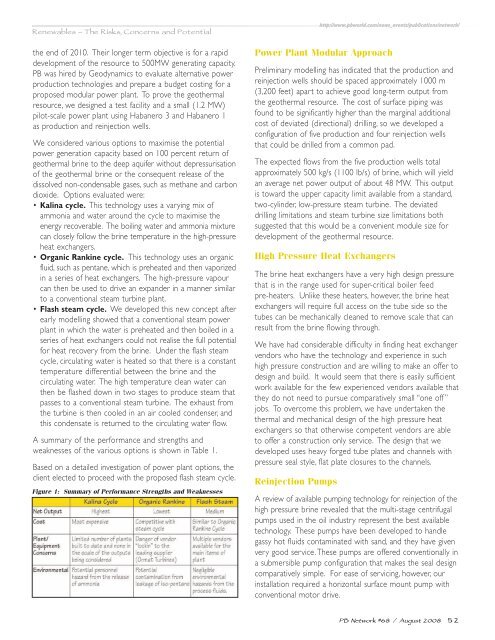Innovation in Global Power - Parsons Brinckerhoff
Innovation in Global Power - Parsons Brinckerhoff
Innovation in Global Power - Parsons Brinckerhoff
Create successful ePaper yourself
Turn your PDF publications into a flip-book with our unique Google optimized e-Paper software.
Renewables – The Risks, Concerns and Potential<br />
the end of 2010. Their longer term objective is for a rapid<br />
development of the resource to 500MW generat<strong>in</strong>g capacity.<br />
PB was hired by Geodynamics to evaluate alternative power<br />
production technologies and prepare a budget cost<strong>in</strong>g for a<br />
proposed modular power plant. To prove the geothermal<br />
resource, we designed a test facility and a small (1.2 MW)<br />
pilot-scale power plant us<strong>in</strong>g Habanero 3 and Habanero 1<br />
as production and re<strong>in</strong>jection wells.<br />
We considered various options to maximise the potential<br />
power generation capacity based on 100 percent return of<br />
geothermal br<strong>in</strong>e to the deep aquifer without depressurisation<br />
of the geothermal br<strong>in</strong>e or the consequent release of the<br />
dissolved non-condensable gases, such as methane and carbon<br />
dioxide. Options evaluated were:<br />
• Kal<strong>in</strong>a cycle. This technology uses a vary<strong>in</strong>g mix of<br />
ammonia and water around the cycle to maximise the<br />
energy recoverable. The boil<strong>in</strong>g water and ammonia mixture<br />
can closely follow the br<strong>in</strong>e temperature <strong>in</strong> the high-pressure<br />
heat exchangers.<br />
• Organic Rank<strong>in</strong>e cycle. This technology uses an organic<br />
fluid, such as pentane, which is preheated and then vaporized<br />
<strong>in</strong> a series of heat exchangers. The high-pressure vapour<br />
can then be used to drive an expander <strong>in</strong> a manner similar<br />
to a conventional steam turb<strong>in</strong>e plant.<br />
• Flash steam cycle. We developed this new concept after<br />
early modell<strong>in</strong>g showed that a conventional steam power<br />
plant <strong>in</strong> which the water is preheated and then boiled <strong>in</strong> a<br />
series of heat exchangers could not realise the full potential<br />
for heat recovery from the br<strong>in</strong>e. Under the flash steam<br />
cycle, circulat<strong>in</strong>g water is heated so that there is a constant<br />
temperature differential between the br<strong>in</strong>e and the<br />
circulat<strong>in</strong>g water. The high temperature clean water can<br />
then be flashed down <strong>in</strong> two stages to produce steam that<br />
passes to a conventional steam turb<strong>in</strong>e. The exhaust from<br />
the turb<strong>in</strong>e is then cooled <strong>in</strong> an air cooled condenser, and<br />
this condensate is returned to the circulat<strong>in</strong>g water flow.<br />
A summary of the performance and strengths and<br />
weaknesses of the various options is shown <strong>in</strong> Table 1.<br />
Based on a detailed <strong>in</strong>vestigation of power plant options, the<br />
client elected to proceed with the proposed flash steam cycle.<br />
Figure 1: Summary of Performance Strengths and Weaknesses<br />
http://www.pbworld.com/news_events/publications/network/<br />
<strong>Power</strong> Plant Modular Approach<br />
Prelim<strong>in</strong>ary modell<strong>in</strong>g has <strong>in</strong>dicated that the production and<br />
re<strong>in</strong>jection wells should be spaced approximately 1000 m<br />
(3,200 feet) apart to achieve good long-term output from<br />
the geothermal resource. The cost of surface pip<strong>in</strong>g was<br />
found to be significantly higher than the marg<strong>in</strong>al additional<br />
cost of deviated (directional) drill<strong>in</strong>g, so we developed a<br />
configuration of five production and four re<strong>in</strong>jection wells<br />
that could be drilled from a common pad.<br />
The expected flows from the five production wells total<br />
approximately 500 kg/s (1100 lb/s) of br<strong>in</strong>e, which will yield<br />
an average net power output of about 48 MW. This output<br />
is toward the upper capacity limit available from a standard,<br />
two-cyl<strong>in</strong>der, low-pressure steam turb<strong>in</strong>e. The deviated<br />
drill<strong>in</strong>g limitations and steam turb<strong>in</strong>e size limitations both<br />
suggested that this would be a convenient module size for<br />
development of the geothermal resource.<br />
High Pressure Heat Exchangers<br />
The br<strong>in</strong>e heat exchangers have a very high design pressure<br />
that is <strong>in</strong> the range used for super-critical boiler feed<br />
pre-heaters. Unlike these heaters, however, the br<strong>in</strong>e heat<br />
exchangers will require full access on the tube side so the<br />
tubes can be mechanically cleaned to remove scale that can<br />
result from the br<strong>in</strong>e flow<strong>in</strong>g through.<br />
We have had considerable difficulty <strong>in</strong> f<strong>in</strong>d<strong>in</strong>g heat exchanger<br />
vendors who have the technology and experience <strong>in</strong> such<br />
high pressure construction and are will<strong>in</strong>g to make an offer to<br />
design and build. It would seem that there is easily sufficient<br />
work available for the few experienced vendors available that<br />
they do not need to pursue comparatively small “one off”<br />
jobs. To overcome this problem, we have undertaken the<br />
thermal and mechanical design of the high pressure heat<br />
exchangers so that otherwise competent vendors are able<br />
to offer a construction only service. The design that we<br />
developed uses heavy forged tube plates and channels with<br />
pressure seal style, flat plate closures to the channels.<br />
Re<strong>in</strong>jection Pumps<br />
A review of available pump<strong>in</strong>g technology for re<strong>in</strong>jection of the<br />
high pressure br<strong>in</strong>e revealed that the multi-stage centrifugal<br />
pumps used <strong>in</strong> the oil <strong>in</strong>dustry represent the best available<br />
technology. These pumps have been developed to handle<br />
gassy hot fluids contam<strong>in</strong>ated with sand, and they have given<br />
very good service.These pumps are offered conventionally <strong>in</strong><br />
a submersible pump configuration that makes the seal design<br />
comparatively simple. For ease of servic<strong>in</strong>g, however, our<br />
<strong>in</strong>stallation required a horizontal surface mount pump with<br />
conventional motor drive.<br />
PB Network #68 / August 2008 52

















